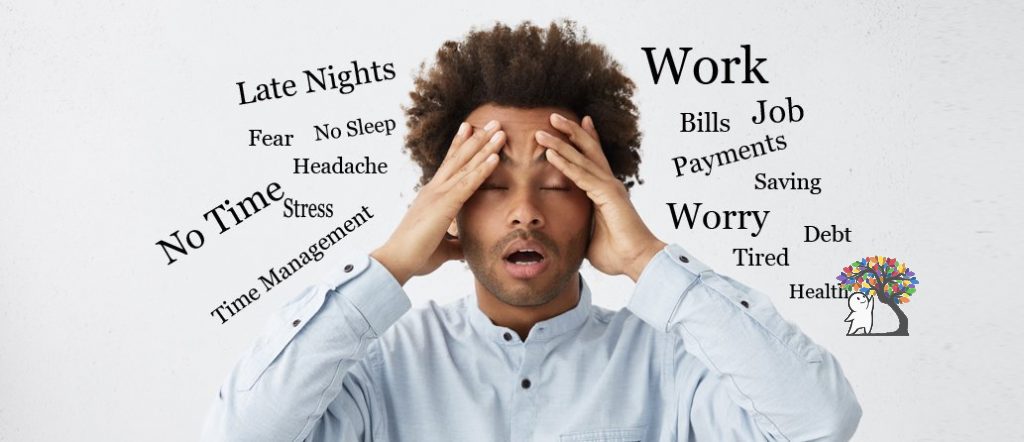4 Ways Anxious Thoughts Sound (and how to deal with them)


Does your anxiety sometimes feel like it’s keeping you in a loop of negativity — a vicious cycle of a narrative that you’d probably never say to a close friend or family member?
Anxiety can make a person way harder on themselves than is necessary. In this article, we’re going to take a look at what different anxious thought patterns might look like and how we can stop these thoughts in their tracks or deal with them in a head-on way. Challenging these negative thought patterns can help us have a healthy internal dialogue and be kind to ourselves.
- Filtering.
Filtering or an anxiety filter is when the lens through which we see the world is negative or filled with worry — in other words, focusing on the good versus the bad. One of the ways this can manifest itself is if you got an essay back that was marked up with both positive and negative notes about the assignment. In this instance, you may take in all of the feedback your professor wrote but focus mostly on the negative comments and beat yourself up. This negative lens with which you’re seeing through has neglected all the positives he or she pointed out to you and is not seeing the larger picture of what you have accomplished. Another example of how filtering works is being nervous ahead of a public presentation, worrying that those listening might not pay attention or, worse, see how nervous you are.
What this worry doesn’t take into account is that everyone watching you present is likely way more preoccupied with how they themselves will perform, and you’re not nearly as much of a focus in their minds as this filter is informing you that you are.
- Catastrophizing.
Catastrophizing is seeing situations as much worse than they actually are. Catastrophizing can take two different forms: making a current situation much worse than it is or projecting a catastrophe in the future as a result of a present situation.
Perhaps if you’ve made a mistake at work, catastrophizing might lead you to think, “I will get fired,” when in fact it leads to a productive conversation with your boss about how to do better in the future. Another example of this is if you have a disagreement with your partner and think, “This person will leave or break up with me.” Neither of these worst-case scenarios have occurred. They live solely in your mind, but catastrophizing puts you in mental state as if they’ve happened, or that they’re the foregone conclusion, when, in reality, there isn’t a way to predict what will actually happen.
Three thoughts that help challenge the catastrophic scenario you fear are: What evidence do I have for this thought? Do I have this thought when I’m calm and positive versus when I’m sad, anxious or angry? What could be a more realistic explanation or outcome?
- All-or-Nothing Thinking.
All-or-Nothing thinking looks a lot like extremes or black-and-white without regard for nuances of a situation. One of the reasons why all-or-nothing thinking can increase anxiety is because it puts an inordinate amount of pressure on a person. To put this into a real-life example, let’s say you ask out someone you’re interested in out on a date. If he or she says no and that leads to thoughts like, “I’ll never find anyone,” or “Nobody will ever be interested in me,” it paints a picture of you as a failure due to a one-off instance.
All-or-Nothing thinking is also harmful because it can sometimes cause your mind to draw a blank when you might want to speak up or act in a way – maybe even take a courageous risk – that can serve you.
One potentially helpful way to reduce extremes in your mind is to evaluate yourself or situations in shades of gray rather than absolutes. Any achievement or outcome can be placed on a scale that’s between 0 percent and 100 percent rather than living on each end of the spectrum.
- The Dangers of “Should” Statements.
A should statement can sometimes be a motivator. “I should work out tomorrow!” can be the motivation you need to move your body and help keep yourself healthy.
However, when it comes to anxiety, “should” statements can make you feel like if you fall short in some way or don’t achieve a benchmark you’ve set for yourself, you’ve failed. Some of these “should” statements could be “I should be able to run a 5k without stopping,” “I should be better at playing piano by now,” “I should be further ahead in my career than I am at this moment.”
Oftentimes, the one setting these rules isn’t anyone else but you. These thoughts also put others on a pedestal – those who can run 5ks without stopping, are perhaps more seasoned at the piano or further along in their careers, and leave us feeling alone. When in reality, there are others who are right there in the same boat as you are, whatever stage you’re in.
One way of helping curb “should” statements is to replace it with the word “prefer.” The inherent self-compassion in a softer statement is oftentimes a better motivator than harsh rules you set for yourself.
What do the anxious thoughts and feelings sound like when you have them? What are some ways you reframe the anxious thoughts that run through your mind? How have you learned to deal with them?
Let us know in the comments!
References:
https://www.mhinnovation.net/sites/default/files/downloads/organisation/catastrophic_thinking_and_how_to_stop.pdf
https://www.progresswellness.com/progress-wellness-blog/2017/2/15/reframing-should-and-combating-anxiety
https://www.medicalnewstoday.com/articles/320844#related-psychiatric-conditions
https://www.verywellmind.com/all-or-nothing-thinking-2584173
https://www.psychologytoday.com/us/blog/turning-straw-gold/201711/how-put-stop-catastrophic-thinking
https://psychcentral.com/lib/what-is-catastrophizing/
https://www.calmclinic.com/anxiety/signs/irrational-thoughts



Responses